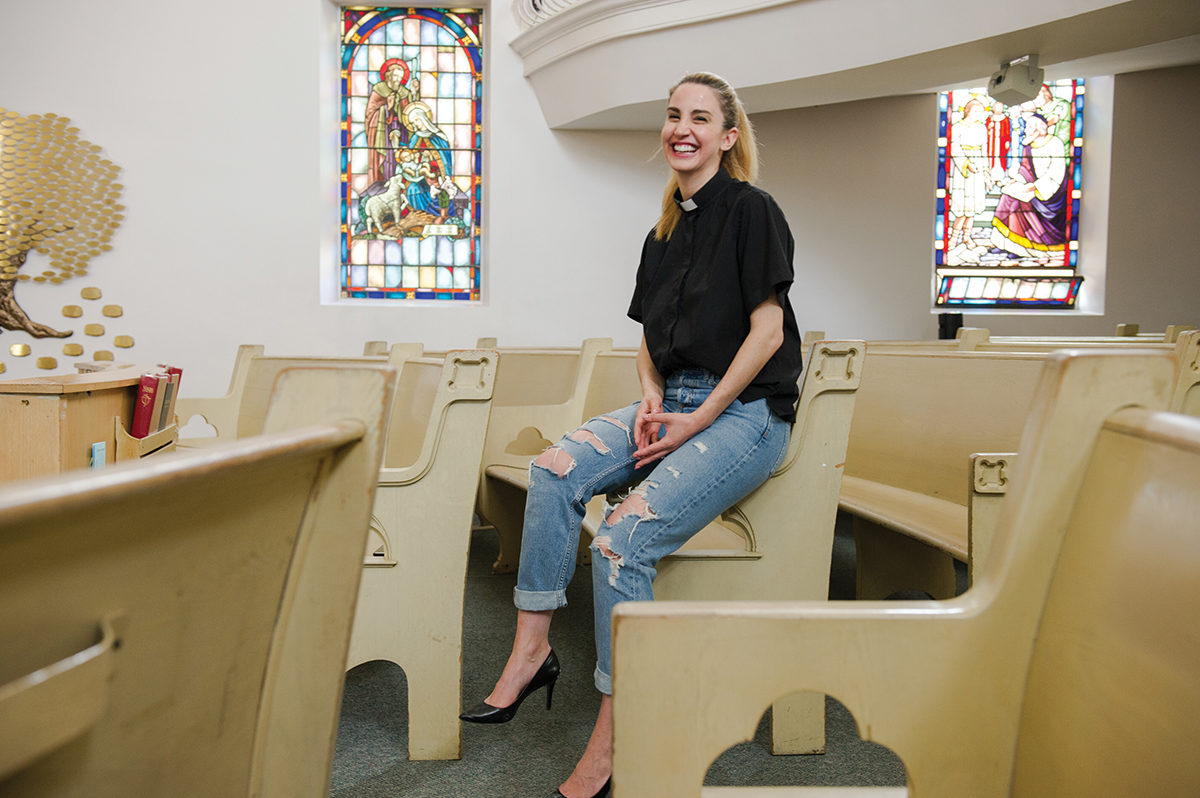The piercing screech of a rotary saw grates on the ears as Bruce Hutchinson, Jack Soule and I thread our way down a hall around a structure of two-by-fours covered in milky heavy plastic. In a few weeks, this structure will become the shaft for a new elevator, intended to make the second floor of Sydenham Street United fully accessible. Soon, construction workers will start carving up other parts of the Kingston, Ont., church building into new offices and rooms of various sizes.
The renovations that Hutchinson and Soule, longtime members of Sydenham Street, are showing me are one part of a bigger, more revolutionary transformation. Last April, this grand old church (built in 1852) was rebranded “The Spire.” Congregation members continue to meet each Sunday in their restful sanctuary. But now they are one among a number of tenants, all paying to support the upkeep on the heritage building. Their fellow tenants in some way match the goals that the congregation set for itself: first, “to be a spiritual community,” second, “to engage in social justice and outreach,” and third, “to nurture and be nurtured by the arts,” says Hutchinson. The Spire, in other words, is becoming a “hub.”
Community hubs, which bring together a variety of organizations under one roof to deliver services and programs more efficiently and cheaply, are a popular idea today. Ontario’s provincial government has created an advisory group specifically to look into opening more of them, although to date it has made little progress.
The United Church is stepping in where governments are slow to tread. The reasons are partly pragmatic: a lot of congregations are static in size or even shrinking, and are saddled with large church buildings, some of which are heritage structures requiring a lot of maintenance. The struggle to keep going is an “energy and financial drain,” says Rob Dalgleish, head of the United Church’s EDGE Network, a group mandated with developing new forms of ministry. These congregations spend much of their time just trying to keep the roof from falling in. Inviting new partners to share their space can help overcome this.
But there’s more to it than self-preservation. Providing a home to an outreach agency or an arts group can advance a church’s commitment to social justice and connect it with the surrounding community, as a “partner of goodwill trying to do good things,” Dalgleish says. “It’s a great way to love your neighbour.”
As Dalgleish pointed out when interviewed for a recent article in the Globe and Mail, the earliest church hubs were probably medieval monasteries that did double duty as breweries, libraries, schools and medical dispensaries. But one of the first United Church examples is Central United in Moncton, N.B. Today, the church is partnered with more than a dozen social agencies in that city’s Community Peace Centre.
Central United, says Sheila Lewis, a longtime congregant who serves on the board of the peace centre, faced the problems that beset many other churches — “declining numbers and declining bank accounts.” In the early part of this century, the church made a brief, unsuccessful attempt at amalgamation with another congregation. The failure left them “a pretty hurting group of people,” says Rev. Jim MacDonald, their minister since 2003. Hurting, but no less determined. They were still convinced there was a role for a church to play in Moncton’s downtown.
Around the same time, a group of Moncton social agencies were discussing whether they might serve their clients more effectively if they were all located together. They dubbed themselves the Community Peace Centre, but Lewis says it was a “concept only. They were still living in their silos.”
In August 2008, after five years during which, says Lewis, they “read books, participated in webinars, attended learning events and spent countless hours debriefing and discerning what it all meant,” two members of the church’s congregation appeared before Moncton’s city council with their preliminary plans to reconnect with the city.
The church was already aware of the peace centre, says Lewis. Whenever they met up, they would “metaphorically shake hands, but we couldn’t see that we could work together.” Then, she says, after their presentation, “the very next morning, it clicked.” People told them, “You guys need to be working together.”
Today, Central United is one of the partners in Moncton’s Community Peace Centre. A four-storey office tower has been constructed next to the church building and connects to it on all four floors. The church and its new community are literally woven together. As one entity, the peace centre and the church provide a total of 6,690 square metres of space for partners ranging from the Multicultural Association of the Greater Moncton Area to a local branch of the Canadian National Institute for the Blind.
The church has given up some of its old space, but as a partner in a new social enterprise, it’s gained much more, says Lewis. “It used to be that a lot of the work we did was charity. Put a Band-Aid on a problem. But now what we do [is] we work in collaboration with the other agencies. We’re working much more on social justice. We do things as partners we would never be able to do on our own.”
Approach Sydenham Street United on foot, and it becomes readily apparent why the church rechristened the building The Spire. Its needle-like tower soars above the surrounding mature trees. Paradoxically, what will help maintain that spire is the rather more banal structure — a Christian education wing — erected in 1961 and attached to the original church. This two-storey building is what workers are renovating and making accessible (the latter thanks to grants from the Rick Hansen Foundation and Employment and Social Development Canada).
Before beginning its transformation, Sydenham Street United was already home to a variety of community groups, and the hope is these will increase once the space is reconfigured. A new management structure is already in place: the church building is now controlled by the Friends of the Spire, which is governed by a board of seven members — four from the church and three from the local community. Hutchinson is its chair. The congregation and its fellow tenants share responsibility for maintenance, with donor support from community members and others. The ultimate goal is to create an endowment fund that will look after the building’s upkeep.
Net result: Sydenham Street United keeps its home but isn’t burdened by exclusive responsibility. A variety of social enterprises gain access to affordable space in a great downtown location. And the wider Kingston community benefits from both.
For any church thinking of transforming itself into a hub, one point that Sheila Lewis emphasizes is “giving yourself time.” Central United worked on its plan for five years; the people at Sydenham Street, says Hutchinson, “spent a year and half on what it was we wanted to become.”
Another key factor is outreach. It’s “really important to talk to the community [about] what the needs are,” Hutchinson says.
Turning a church into a sustainable hub will never be easy. And for some churches, it may simply not be possible, particularly if it would require extensive renovations. “There are issues if it’s a stone building,” says Dalgleish. “If you have to move walls, it’s expensive, and for older churches there are heritage questions.” Local bylaws may prevent a church from making needed changes.
That aside, EDGE and others within the church are doing what they can to make it easier. St. Andrew’s United in Markham, Ont., is an example of what might be possible. When Rev. Katherine Selby was approached by business coach Peter Miller and Carla Leon, EDGE’s manager of new initiatives, to see if she would be interested in having St. Andrew’s host a pilot hub project, she readily agreed. “I want this church to be a place where people in the community can come in for support or inspiration or to volunteer in a way that inspires them,” she says.
Miller, a retired banker and business educator who now works with EDGE as a volunteer adviser, helped to find likely tenants. “There were two requirements,” he says. “They had to be in the GTA, and they had to have a ‘giving-back’ component.” St. Andrew’s is now home to more than a dozen of what Miller dubs “hubsters.” They are involved in a range of socially useful activities: three deal with issues of incarceration, and another measures the effectiveness of social innovation. As well as space, they are receiving business mentoring from Miller. “They’re very innovative, they’re very creative and they need help,” he says.
At some point, Miller will step away from St. Andrew’s and begin working with other churches. He is also writing a manual to aid those interested in creating hubs. What he plans won’t just be for the United Church. “The whole concept, really, is to build a community, and it can be a mosque, it could be temples, it could be synagogues.” But for a number of reasons, the United Church is uniquely suited to create these communities. For one, there’s its structure. As Hutchinson says, “In the United Church, there’s probably more freedom to do something different than you’d find in a [more] hierarchical church.” Second, the United Church has a positive reputation for social justice, which helps attract partners. “People still respond to that very, very strongly,” says Dalgleish. Finally, there’s capacity. The denomination has about 3,000 church buildings across Canada, a third of which need to be sold, redeveloped or somehow repurposed, according to a 2014 survey.
These buildings are often seen as liabilities. But maybe they are assets.
This article first appeared in The Observer’s November 2017 issue with the title “Same building, new purpose.”


Comments